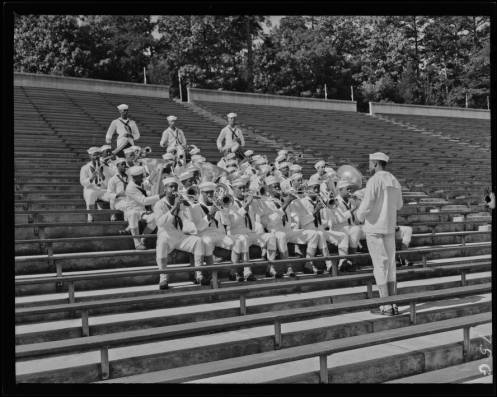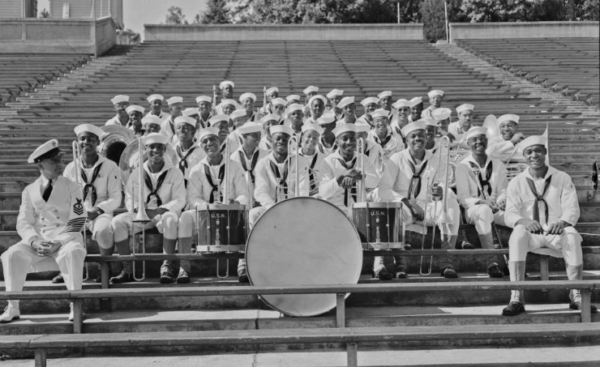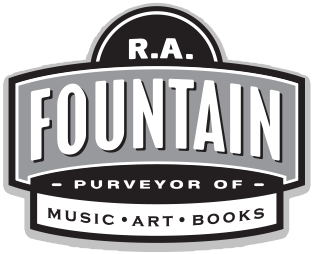- 6754 E. Wilson St., Fountain, NC 27829
- 252.749.3228
- My Account
Chief Bandmaster C.E. Dudrow was brought out of retirement by the Navy to recruit the bandsmen who would form B-1. He visited Greensboro several times in early 1942 and auditioned the A&T College and Dudley High School students who would form the nucleus of B-1, and he was B-1’s first leader.
Dudrow’s father was a drummer boy with the Union Army during the Civil War, and he “inherited his father’s musical ability, to become a skilled trap drummer.” He enlisted in the Navy in 1906 and spent most of his career at sea, “and he has a salty yarn for every year.”
He once “tooted a horn and heard the echo rebound agains the sinister rock walls of the channels of the Straits of Magellan,” in 1907, as he sailed with Theodore Roosevelt and the battleships Washington and Tennessee. “A number of old timers have rounded the Horn,” he said, “but few go through the Straits.”
During World War I, he served on patrol duty off the coast of Brazil, and after the war, he led a band at the Naval Training Station at San Diego.
After getting B-1 settled in to its Chapel Hill duty, Dudrow was transferred to the Norfolk Naval Air Station, and James B. Parsons, Mus1c “was named to succeed Dudrow as officer in charge” of B-1.
–“Navy Bandman Is Moved after Work at Carolina,” Raleigh News & Observer 29 Nov. 1942: 6.
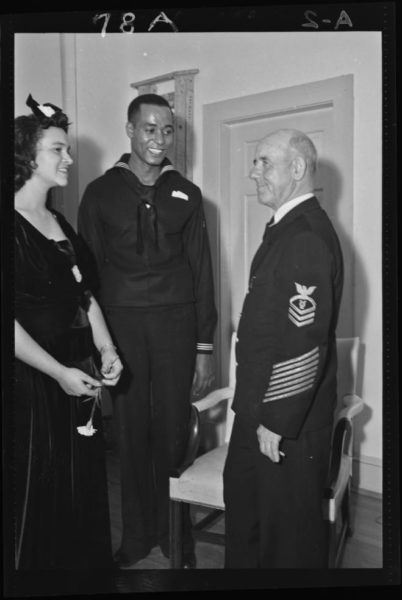
Photographic Archives, North Carolina Collection, UNC-CH
Note: The above referenced article suggests that Dudrow’s service as bandleader at the San Diego station came after World War I but also that his band “was one of the features of the San Diego Exposition.” Both could not have happened as the Expo closed on January 1, 1917, and he couldn’t have been in charge of a band at the San Diego station during the years of the Expo because the Navy didn’t establish its San Diego station until about 1920. The San Diego band may have been featured after the war at Balboa Park, the site of the Expo, but until more details about Dudrow’s remarkable career are known, it’s impossible to know.
Parsons was promoted from Mus2c to Mus1c just prior to Dudrow’s transfer.
In this photo
Chief Bandmaster Dudrow (R), greeted by James B. Parsons, Mus1c, and his date at a 1942 party in Chapel Hill.
Dudrow’s sleeve contains service stripes on the cuff and his Chief’s rating badge on his. Note the rocker above the chevrons. In 1957, one and two stars were added above that rocker to denote senior and master chiefs, respectively. The service stripes are added for every 4 years of good conduct. Initially, they are red. Once a sailor achieves 12 years of consecutive good conduct, the service stripes are gold.
All seven of Dudrow’s stripes are gold.
–Bayes, Mike. Email to author. 30 Aug. 2020
• • •
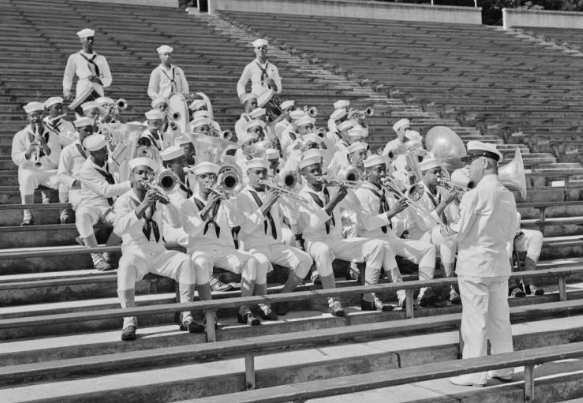 It’s easy to imagine that these three photographs depict the 1942 transfer of the baton from Chief Bandmaster Dudrow, conducting the band in the top photo, to Mus1c James Parsons, who’s conducting it in the second photo. In the third, Dudrow sits at bottom left and Parsons at bottom right.
It’s easy to imagine that these three photographs depict the 1942 transfer of the baton from Chief Bandmaster Dudrow, conducting the band in the top photo, to Mus1c James Parsons, who’s conducting it in the second photo. In the third, Dudrow sits at bottom left and Parsons at bottom right.
